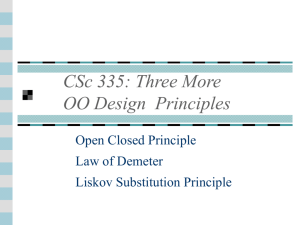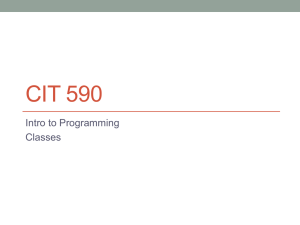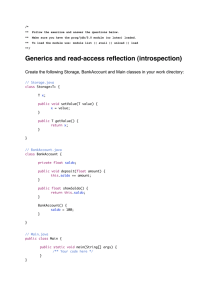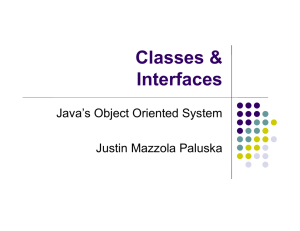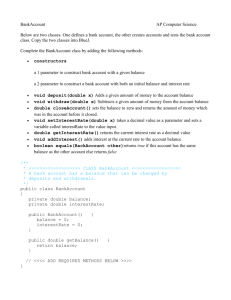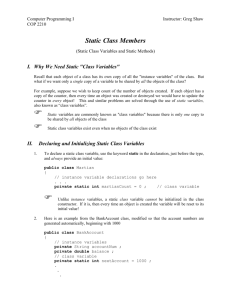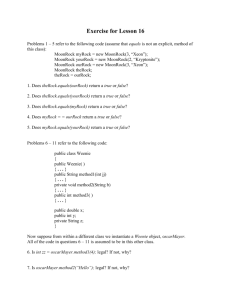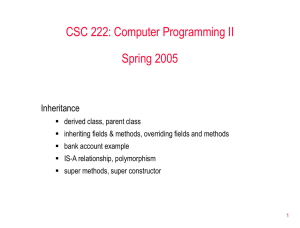26-PrinciplesofOOD
advertisement
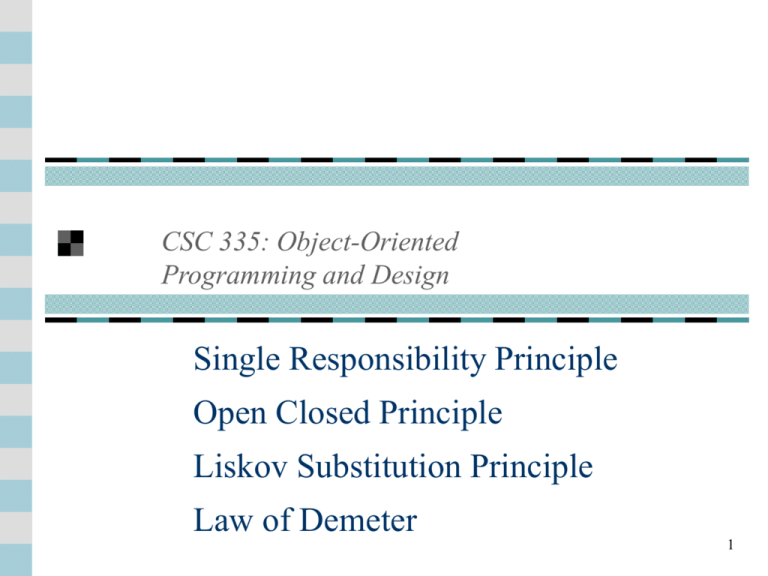
CSC 335: Object-Oriented
Programming and Design
Single Responsibility Principle
Open Closed Principle
Liskov Substitution Principle
Law of Demeter
1
Four Design Smells
Rigidity-One change requires many other
changes
Fragility-One change breaks other parts
Immobility-Can't pull out a piece to reuse
Needless Repetition-Repeated code is evil, to
change the logic, change must happen in
many places
2
Single Responsibility Principle
Classes should have a single responsibility
http://en.wikipedia.org/wiki/Single_responsibility_principle
If you have a class doing two things, split it
http://www.refactoring.com/catalog/extractClass.html
Cohesion, if high, reduces complexity,
makes the system more understandable
Maintenance: Fixing or changing a module
should not break other parts of the system
3
Open Closed Principle
"All systems change during their lifecycles. This must be born in mind when
developing system expected to last longer
than the first version", Ivar Jacobsen
Software entities (classes modules,
functions, etc) should be open for
extension but closed for modification,
Bertrand Meyer 1988
Now known as the Open-Closed principle
4
Modules that never change?
If a change to one module (class or method)
results in a cascade of changes to other modules,
you have bad design
When requirements change (and they always do),
your design should allow developers to extend the
behavior by adding new code, good design, not by
changing the behavior of existing code
5
Open and Closed?
The behavior of a module should be
extended--as in adding behavior
can add extensions to a house leaving the other
rooms intact at least relatively
You will be using the abstract classes and
extends to do this, or interfaces and
implements
The source code of this kind of module can
not be changed
6
One Design
Imagine Client represents any module that
depends on some other module named
Server
7
Abstraction
Client depends on an abstraction that does
not change. It could be an abstract class or
an interface
8
Example: Strategy Pattern
Previous UML showed the general form
Next slide shows has UML diagram of a
specific application of the Strategy pattern
It is also an application of the open closed
principle
Why?
Which class plays the role of client?
Which class plays the role of AbstractServer?
9
Example: Strategy Pattern
10
Other Examples
Strategy is Open-Closed Principle because
implementing a new Strategy does not require a
change to the Player Class
This class is essentially closed for modification
However, because we can pass in an object
that implements ComputerStrategy, the class is
open for extension
Extending Player (the client) only requires new
modules (classes) be written that implement
ComputerStrategy,
There are no changes to the existing Player
11
Other Examples
Eclipse
Plugins can be added to with no changes to Eclipse
A plugin "extends" Eclipse once you figure out where
the "Extension Points" are (see plug in page)
Using List parameters and return types
A module depends on List rather than a concrete class
like ArrayList, LinkedList, or Vector
If you change ArrayList, or develop a new List class,
you don't need to change the module that depends on it
12
Comparator is Open Closed
public class ComparatorTest {
@Test public void testComparators() {
BankAccount a = new BankAccount("A", 5);
BankAccount b = new BankAccount("B", 100);
BankAccount c = new BankAccount("C", 3000);
BankAccount d = new BankAccount("D", 200);
BankAccount e = new BankAccount("E", 50);
List<BankAccount> accounts =
new ArrayList<BankAccount>();
// Add "randomly" so these are not sorted.
accounts.add(e);
accounts.add(c);
accounts.add(d);
accounts.add(a);
accounts.add(b);
13
Comparator is Open Closed
Comparator<BankAccount> idComparator = new ByID();
Collections.sort(accounts, idComparator);
System.out.println(accounts);
// First element has the alphabetically first ID
assertEquals("A", accounts.get(0).getID());
Comparator<BankAccount> balanceComparator
= new ByBalance();
Collections.sort(accounts, balanceComparator);
System.out.println(accounts);
// First element has the most money
assertEquals("C", accounts.get(0).getID());
}
}
14
The Two Comparators
import java.util.Comparator;
public class ByID implements Comparator {
public int compare(Object arg0, Object arg1) {
BankAccount left = (BankAccount) arg0;
BankAccount right = (BankAccount) arg1;
return left.getID().compareTo(right.getID());
}
}
public class ByBalance implements Comparator {
public int compare(Object arg0, Object arg1) {
BankAccount left = (BankAccount) arg0;
BankAccount right = (BankAccount) arg1;
return (int) ((100 * right.getBalance()) - 100 *
left.getBalance());
}
}
15
Liskov Substitution Principle
The Liskov Substitution Principle of object
oriented design states
In class hierarchies, it should be possible to
treat a specialized object as if it were a base
class object
Code with a reference to a base class should
be able to use objects of the derived class
without knowing it
16
From the source in 1988
Barbara Liskov first wrote this:
“What is wanted is something like the
following substitution property: If for each
object o1 of type S there is an object o2 of type
T such that for all programs P defined in terms
of T, the behavior of P is unchanged when o1 is
substituted for o2, then S is a subtype of T.“
Or more simply:
Subtypes must be substitutable for their base
types"
17
Consider this code
public class Rectangle {
protected int _width;
protected int _height;
public int getWidth() {
return _width;
}
public int getHeight() {
return _height;
}
public void setWidth(int width) {
_width = width;
}
public void setHeight(int height) {
_height = height;
}
}
18
Let Square be a subtype of
Rectangle
class Square extends Rectangle {
@Override
public void setWidth(int width) {
_width = width;
_height = width;
}
@Override
public void setHeight(int height) {
_height = height;
_width = _height;
}
}
19
Compiles, but does it pass?
import static org.junit.Assert.*;
import org.junit.Test;
public class RectangleTest {
@Test public void testArea() {
Rectangle r = new Square();
r.setWidth(5);
r.setHeight(2);
// Does this assertion pass?
assertEquals(10, r.getWidth() * r.getHeight());
}
}
20
Solution?
If the behavior by Square is unacceptable
and unexpected, Square should not be
derived from Rectangle
21
Why follow Liskov?
Liskov basically wants you to think
clearly about the expected behavior and
expectations of a class before you derive
new classes from it
It could turn out that when subtypes are
substituted for a parent, you may get
unexpected results
Unit tests help avoid this problem
22
Law of Demeter
A style rule for designing object-oriented systems
"Only talk to your immediate friends"
Name of the Greek Goddess of Agriculture
Each module should have only limited knowledge
about other modules
In other words, grow software in small steps
Those "closely" related to the current unit
Each module only talks to friends
“Don't talk to strangers”
Law of Demeter
This is low coupling in software engineering
made more explicit
Try to avoid knowing about the structure of
indirect objects
Use the direct object that you need to know
about and let that object talk to indirect objects
Who are closely related friends?
From
a method, messages can be sent
to
object
a parameter of the method
an instance variable of this object
an object created within the method
this
FRIENDS
An Example
Widely used in big projects, for example, at
JPL for the Mars exploration software, the
quote
The Law of Demeter … has taken a firm hold in
many areas of JPL. Major systems which have used
LoD extensively include … Mars Pathfinder
Software (begun in 1993). We are going to use LoD
as a foundational software engineering principle for
the X2000 Europa orbiter mission.
Grady Booch Quote
The basic effect of applying this Law is the
creation of loosely coupled classes, whose
implementation secrets are encapsulated. Such
classes are fairly unencumbered, meaning that
to understand the meaning of one class, you
need not understand the details of many other
classes.
Abstract example
class A {
private B b = new B();
public void m() {
this.b.c.foo();
}
// High coupling: bad
}
class B {
C c;
}
class C {
public void foo() {
}
}
Silly example you may someday code?
Which code represents the better design?
// a.
dog.body.tail.wag();
// b.
dog.expressHappiness();
The bad example couples dog to two indirect classes
DogBody, and DogTail
The good design couples dog only to the direct class
DogAnimal
